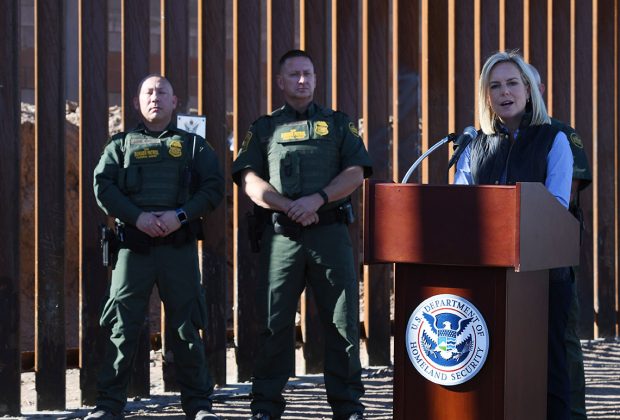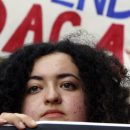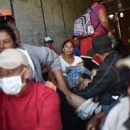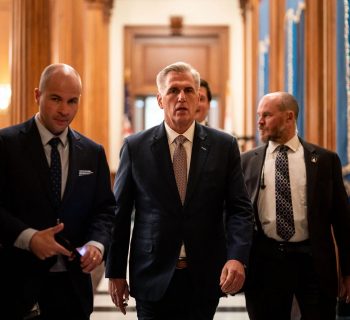By Timothy Noah ~ Politico ~ November 2, 2018
To find a year with fewer border arrests than 2017, you'd have to go back all the way to 1971.
Throughout this election season — and ever since he declared his presidential candidacy — President Donald Trump has been calling illegal immigration a “crisis.”
“I would like to provide an update to the American people regarding the crisis on our southern border,” the president said in his Thursday speech on the subject, “and crisis it is.”
But the numbers tell another story.
The word “crisis” typically describes a problem that’s getting worse. According to Customs and Border Protection, arrests along the southwest border — the standard metric used to calculate illegal border crossings — numbered 396,579 in fiscal year 2018, which ended Oct. 1. That’s lower than the average over the previous decade(400,751). It’s also lower than the number of border arrests in fiscal 2016, 2014 and 2013.
It’s true there were more border arrests in 2018 than in 2017, a development that prompted Trump to level blistering criticism against Homeland Security Kirstjen Nielsen, and that led Attorney General Jeff Sessions to impose — without consulting DHS — the “zero-tolerance” border arrest policy that led to last spring’s surge in family separations.
But in 2017, border arrests had dropped to a historic low; to find a year with fewer border arrests, you have to go back all the way to 1971. Indeed, a September 2017 report by the Department of Homeland Security was able to boast — somewhat inconveniently as Trump sought to secure funding for a wall along the southern border — that “the southwest land border is more difficult to illegally cross today than ever before.”
And border arrests over the past decade, averaging 400,000 annually, are very low compared with recent history. In the 1980s and 1990s, border arrests seldom fell below 1 million. Border arrests peaked at 1,643,679 in 2000, and remained at or near the 1 million mark until the last two years of George W. Bush’s presidency.
Tougher border enforcement likely helped explain the decline in border arrests in the late 2000s, but the principal reason, experts agree, was a decline in illegal border crossings by Mexicans attributable initially to improvements in the Mexican economy and later to the Great Recession of 2007-2009.
After the recession ended, Mexican border crossings stayed low; in 2017 alone, the population of Mexican-born immigrants in the U.S. dropped more than 300,000, according to an analysis of Census data by the Pew Charitable Trusts. “The sudden plunge,” Pew reported, “seems to be an acceleration of a long-term trend of native Mexicans returning to their homeland.”
As Mexican border crossings declined, Central American border crossings increased. According to Pew, the U.S. population from the Northern Triangle countries of El Salvador, Honduras, and Guatemala has more than tripled since 1990, accelerating a trend that began in the 1980s with the rise of violence in those countries. But this substantial increase in Central American immigration, most of it illegal, has not come close to offsetting the decline in Mexican immigration.
One common justification for declaring immigration a crisis rests not on the number of immigrants crossing the border illegally, but on the mayhem they create after they arrive. “Republicans … want to make strong borders,” Trump said in his Thursday speech, “want to get rid of any crime because of the borders, of which there’s a lot.”
But study after study has shown that immigrants commit crimes at a lower rate than the general population. In a March study specifically focused on undocumented immigrants, University of Wisconsin sociologist Michael Light examined the relationship between illegal immigration and violence in 50 states and Washington, D.C., over a 24-year period ending in 2014 — a span that included the peak years for border arrests. His conclusion: “Undocumented immigration does not increase violence. Rather, the relationship between undocumented immigration and violent crime is generally negative.”
Another justification to label immigration a crisis is that it lowers wages for native-born workers. But economists have struggled to find evidence of this. George Borjas, a Harvard economist who favors more restrictionist immigration policies, concluded in his 2016 book “We Wanted Workers” that high school dropouts were the only group of native-born workers that lost significant income (about 3 percent) over the long term as a result of immigration during the peak years of 1990-2010. Individuals who graduated high school but never received a college degree — a core Trump constituency — actually experienced long-term wage gains as a result of this immigrant “supply shock,” Borjas found.







